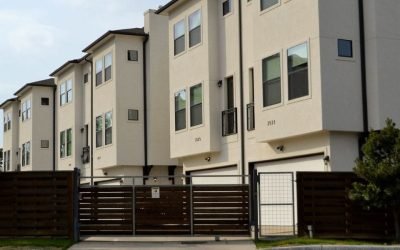If you’re new to property investment you’re likely to start to run into terms and acronyms that you’ve not heard before, such as BTL property. So, what is a BTL property?
BTL stands for “buy-to-let” and refers to properties that are rented out by landlords who want to earn money on their investment. These properties are usually located in desirable areas and are maintained by the owner, rather than the tenant.
Given the current poor rate of returns available to savers, you might be considering investing in a property to create a new income stream. You would buy a property not to live in, but to let out to a tenant.
What is a buy-to-let?
A buy-to-let (BTL) is an investment in a property with the specific aim of retaining ownership and renting it to a tenant or tenants, who pay rent to the landlord.
They could be houses, flats, or house shares, generally found close to popular areas where buying prices are often very high. In those areas, renting has become an affordable living option and the location is typically a deciding factor. For example, for those looking to stay within walking distance of work or to be close to certain facilities.
The advantage to the tenant is being able to live in a location they might otherwise not be able to afford. The advantage for the landlord is regular income that should not only cover the house costs (e.g. maintenance and mortgage) but also provide a profit.
How does buy to let work?
BTL is a type of ownership where the landlord rents out a property to a tenant and receives a monthly rent payment. The landlord is the legal owner, but the tenant is the one that pays the rent.
When you purchase a property to let out, you become the landlord.
You need to make sure your rental payments are higher than the cost of maintaining and letting agent fees, as well as monthly mortgage repayments. This requires you to do your due diligence before purchasing the property which will involve calculating the yield, but more on that later.
You will also pay Stamp Duty when purchasing a buy-to-let property, and may need to pay for renovation or improvement work before renting it out for the first time.
There are also taxation rules to consider. You will have to declare the income from your second home in a self assessment tax return. If you are unfamiliar with tax returns I highly recommend contacting a chartered accountant for advice, we’d recommend our accountant, Chris Oxley, from UHY Hacker Young
The pros and cons of buy-to-let
There are many reasons why people choose to invest in buy-to-let properties, such as capital gains and rental income. It’s important to be aware of the potential disadvantages of buy-to-let properties before making an investment decision.
Regular Income
The primary reason people invest in BTL properties is to generate a regular income from tenants. It can be seen as a safe haven, providing a steady flow of income that doesn’t rely on market fluctuations.
Of course, that all depends not only on having tenants, but having good tenants who pay their rent on time.
Increased Value
Purchasing to rent is a long term strategy and you don’t just invest in the purchase of the property, you must also keep it well maintained. By doing so you should find your investment grows in value, which means you could turn a tidy profit in the future should you choose to sell it.
The housing market can be unpredictable, but property usually has a long-term value. The key is to invest in the right location, pick the wrong one and you may not see any increase, or worse, your investment may decline in value.
We decided to purchase a few properties in the North East of the UK. We live in Manchester so they are a long way from home. We have a lot of stories to tell about those properties but one thing we wanted to say was that the ROI hasn’t been that great in terms of capital growth. The yield was good when we purchased them but that area has been pretty stagnant growth-wise. We’ve owned the properties for 10 years now and they are only just starting to go up in value. But we figured that if we held them for long enough they would eventually go up in value and we are seeing that now.
Multiple properties = multiple income
The dream for most property investors is to replace their current income with that from owned properties, allowing them to quit the day job and live off the income. The more properties you own, the greater the regular income.
Of course, owning multiple properties also increases your maintenance and repair costs. It also means you have more to manage (e.g. finding new tenants), ultimately, multiple property ownership can become a full-time job. If you are in the great position to give up your day job then being a landlord can be a great full-time job, it gives you time freedom, and flexibility, which a full-time job doesn’t do.

Property Investment: How to conduct due diligence
When you’re considering investing in property it is very important to do your research first. I can’t overstate how important your due diligence is when buying property.
If you’re unfamiliar with this concept, due diligence means that you do your research into the property you are looking to buy to make sure the investment stacks up.
The process is simple and will follow this pattern:
- A very quick assessment of rental to purchase price
- Determine the post code of the property
- Find the property on Right Move
- Find comparable property on Right Move
- Find out what those properties are worth now in the eyes of the lenders
- Confirm the rental amount for the property for both private and LHA tenants
- Checking ownership of the property to make sure you speak to the right people
- Do it – Delegate it – Ditch it – your decision
In order to check the rental price Right Move is a great resource. We also find that calling up local agents is invaluable. They are usually very friendly and happy to help.
Property Investment: How to calculate the yield
It’s also important during this process to calculate the yield that you will receive from the property.
Make sure you know how to work out the rental yield on a property. The calculations are shown below:
Gross Yield = annual rent/purchase price
Net Yield = annual rent less running costs/purchase price
We find it much safer to work with the net yield, as this gives you a truer picture as to what will end up in your pocket at the end of the month. You should also build in some contingency to your figures in case of a worst-case scenario happening.
Here is an example to show you how this works:
- You are looking to purchase a property for £100,000.
- From research you know that the market rent will be around £600 a month.
Gross Yield
Annual Rent = £600 x 12 = £7,200
Gross Yield = £7,200/£100,000 = 7.2%
Net Yield
If running costs are £300 a month then the net yield would look like this:
Annual running costs = £300 x 12 = £3,600
Annual Rent – Annual running costs = £3,600
Net Yield = £3,600/£100,000 = 3.6%
If you can’t remember the difference between net and gross, just think of the net term as a fishing net in a big pond. The fishing net is smaller than the big pond!
We usually look for a 7%+ gross yield when we are analysing a property.
Buy to let mortgages explained
Unless you’ve got substantial savings to purchase your first BTL property you are going to need to take out a mortgage. In theory, renting covers the mortgage payment, but be aware that you’ll still need to pay even if you have no tenants and the place is empty.
What is a buy to let mortgage?
A buy to let mortgage is a type of loan that is designed for investors. The investor is the owner who rents out the property to tenants, you become the landlord.
It’s important to note that typically you cannot live in a property that you purchase using a buy to let mortgage and most buy to let mortgages are interest only.
Interest-only mortgages are often used by landlords because they do not require repayment until the end of the mortgage period. This makes the monthly payments lower than other types of loans, but does mean you need a way to repay the borrowed amount at the end of the period.
For buy to let landlords, the easiest way to repay the mortgage is to sell the property, hopefully making a profit due to an increase in housing prices.
How do buy to let mortgages work?
Buy to let mortgages are loans that allow landlords to purchase properties on behalf of their tenants. The tenant pays rent directly to the landlord, who then uses the money to pay the mortgage. This arrangement allows landlords to invest in rental properties without having to spend time managing them.
The process of buy to let mortgages works similarly to traditional mortgages. You apply for a loan through a bank or lender, and if approved, you receive funds to use towards purchasing a property. Once you’ve purchased the property, you must register it with HM Land Registry. Then, you must find tenants and collect rent.
Interest only mortgages are common for buy to let properties. The monthly payments will only pay off the interest on the loan, and you don’t need to pay off the full sum of the mortgage right away.
There are three main differences between buy to let mortgages and residential mortgages:
- Deposit size;
- Riskiness;
- What can be charged in rent.
Note that not everyone will be eligible for a BTL mortgage as terms often include Interest Cover Ratios (ICRs).
An Interest Cover Ratio is the ratio a property’s rental income covers the mortgage payments. The ratio is used by lenders to assess how much money the landlord is likely to make.
In other words, before you’re given the funds to purchase your rental property the lender must be confident you can make the rental income predicted.
A good way to check you’re on the right track with your figures is to be your rental pricing on similar properties in the area you’re looking to invest in.
Portfolio landlord mortgages
A portfolio mortgage is a type of mortgage that allows borrowers to buy multiple properties at once. The borrower pays one monthly payment on their mortgage regardless of how many properties they own. This means that if the value of a single property drops, the borrower won’t lose money.
If you apply for one of these you will be required to provide information about your business and properties included.
If you are just starting out, this type of mortgage wouldn’t be suitable for you.
Switching to a BTL mortgage
If you’ve checked the house prices and decided that it’s not the right time to take on a second mortgage you might consider renting a room in your existing house. Be aware your existing lender should be consulted before doing this, if you have an owner-occupier mortgage renting a room out may invalidate the agreement you have in place.
There are several possible outcomes, you might be granted a “consent to let” authorisation from your current lender, meaning nothing needs to change financially but that you’ve been given the green light to rent out a room.
If this isn’t the case you will likely need to remortgage, either with your existing lender or by moving to a new lender, in order to obtain a BTL mortgage.
For independent advice on this matter, we recommend getting in touch with our mortgage broker, Emma from The Didsbury Mortgage Company
What will my responsibilities as a landlord be?
As a landlord, you will be responsible for ensuring that the property is safe, that the building is in good repair, and that the tenant is paying the rent on time. You will also be responsible for making sure that the tenant is not causing any problems for the neighbours of the property.
Although some responsibilities can be outsourced (e.g. to an estate agent) you must still be prepared to:
- Provide tenants with a habitable home.
- Keep the property in good condition.
- Provide required information about the rental agreement.
- Meet tenants’ reasonable needs
- Protect tenants deposits.
You are generally allowed to terminate a tenant’s lease in the following situation:
- Non-payment of rent
- Breaking the terms and conditions of the lease agreement
- Hazardous or illegal behaviour on your property.
A landlord may evict a tenant for breaking the agreement or for criminal activity on the property, but only after giving them proper notice and an opportunity to fix the issue.
We recommend you consult with a lawyer when making any changes to the tenancy agreement, such as increasing rent or terminating it early.
As a landlord, it is also your responsibility to ensure mortgage payments are met, and you may end up in a repossession situation if you do not keep up with repayments.
Deposit protection schemes
As a landlord, you will want to take a deposit from incoming tenants in order to cover the cost of any damage discovered when they eventually move out.
You will need to have a deposit protection scheme in place to protect the deposits given over by renters, and you’ve two types to choose from:
Insurance: The landlord or agent retains the deposit and pays interest to the insurer.
Custodial: The deposit held by the scheme provider rather than the landlord or agent.
Both types are designed to assist in resolving issues between landlords and tenants and have been introduced to help protect tenants from landlords who refuse to return the deposit without a valid reason.
How do I get started with buy-to-let?
If you’re considering investment properties to add rental incomes to your monthly earnings the first thing you should do is read our getting started guide, which can be downloaded for free below.


